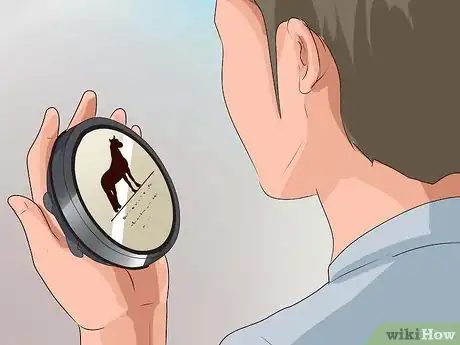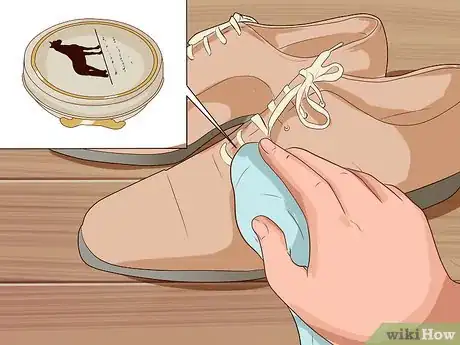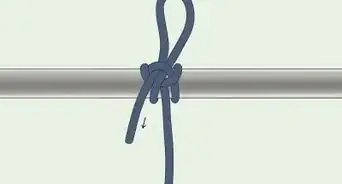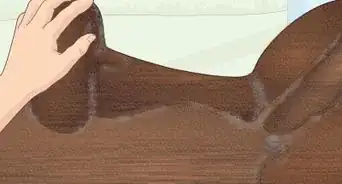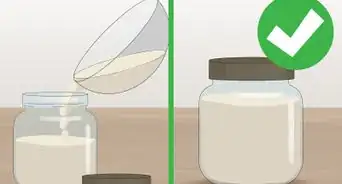wikiHow is a “wiki,” similar to Wikipedia, which means that many of our articles are co-written by multiple authors. To create this article, volunteer authors worked to edit and improve it over time.
This article has been viewed 59,472 times.
Learn more...
Saddle soap is a cleaner primarily used to clean leather. While, as the name implies, it can be used on horse's tack it can also be used to clean shoes and as a protective agent for boots. Learn about saddle soap before using it and make sure the brand you choose won't be too hard on leather.
Steps
Selecting Saddle Soap
-
1Read the manufacturer's directions. Saddle soap can be used to clean horse tack and other leather products such as shoes and boots. However, saddle soap should not be used on every leather-based product.
- There are a variety of different types of leather used in products. Different types require different cleaners and the only way to know whether saddle soap is okay is to consult the manufacturer's directions.
- If you don't have the directions handy, you can google the product name and find information online about cleaning and care. If you see any warnings about saddle soap, it might be better to go with a different cleaner.
-
2Avoid lye heavy products. Lye is a highly caustic compound found in many commercial brands of saddle soap. If lye is listed as a primary ingredient on the brand of saddle soap you've selected, you might want to ditch that product and look for an alternative brand.
- Lye's caustic nature mean it's particularly hard on leather products. It absorbs moisture quickly, which can dry out leather causing it to crack, split, and otherwise deteriorate faster.
- Saddle soap made with lye also has a high pH level, which causes leather to harden and darken. It can be difficult to get lye-heavy saddle soap out of cracks and crevices if you're cleaning tack, resulting in a crusty white residue.
- Opt for making your own saddle soap or try to buy homemade saddle soap from a local farmer's market. While such products do use lye, they tend to use it in reasonable amounts that will cause minimal damage to leather.
Advertisement -
3Make your own saddle soap. You can make inexpensive saddle soap in your own kitchen. This might be a better option than buying commercial saddle soap, as the products used can be harmful to leather.
- Use protective gloves throughout the cooking process. You'll be handling lye, which is a pretty heavy-duty material. You want to make sure you avoid burning your skin. Use an apron to cook, as lye should not come into contact with clothes you wear regularly.[1]
- Get your ingredients. You'll need two pots, made of stainless steel or heat-resistant glass, a stainless steel spoon, and some kind of jars or boxes to store the concoction. You will also need beeswax, pure flake lye, castile soap shavings, water, and pure gum turpentine. These products can be purchased at grocery stores, hardware stores, and health food stores.[2]
- In one pot, combine 6.25 parts beeswax, 10 parts pure flake lye, and 10 parts water. Boil the mixture for 5 minutes, stirring constantly.[3]
- Get the second pot. Melt together 2 parts castile shavings and 10 parts water. Once the soap liquifies, add it to the first mixture.[4]
- Move the pot away from heat and add 15 parts turpentine. Pour the mixture into containers, cover, and store the saddle soap in a cool and dry part of your home. The soap does not have a shelf life, so you can wait as long as you want to use it.[5]
- When you finish, clean your kitchen thoroughly. Keep your protective gloves on during this time. Lye can be harmful if ingested, so you want to make sure your kitchen is clear of lye before you begin cooking and eating again.[6]
Cleaning Saddles and Tack
-
1Prepare your tack for cleaning. Before you begin cleaning bridles and saddles, you need to get them ready.
- Undo any buckles on the tack and remove steel components, like those found in stirrups and bits. You do not want to get soap, saddle or otherwise, on the bit especially. Saddle soap can be harmful to your horse if ingested.
- Dip a soft cloth in warm water. Wring out the cloth until it is damp but not wet and wipe the saddle off. Allow it to dry completely before beginning the cleaning process. This opens the pores of the leather for a deeper clean. It can also prevent the leather darkening associated with saddle soap use.
-
2Clean the saddle. After your saddle has dried, you can begin the process of cleaning it with saddle soap.
- Use a sponge that's been soaked in warm water. Do not use hot water, as this can damage the saddle. Aim for lukewarm.
- Apply a small amount of saddle soap to the sponge.
- Scrub down the saddle, scrubbing in a circular motion. If your saddle has a lot of hard-to-reach places, use a toothbrush in addition to your sponge.
- Using a clean and dry cloth, wipe the soap residue from the saddle. Make sure you get all the soap off, as you do not want white, crusty residue to surface after the saddle dries.
-
3Finnish up cleaning. Once you're saddle has dried after the application of saddle soap, there are a few more steps to the cleaning process.
- To condition the leather and keep it moist and shiny, invest in a high quality leather conditioner. Neatsfoot oil is a good option. However, use oil sparingly as it can seep into padding under the saddle and cause damage. Consult the directions on the bottle before application to get a sense of how much you should use.
- Metal parts of the saddle, like stirrups, should not be washed with saddle soap. Instead, use warm water and dish soap.
Using Saddle Soap on Footwear
-
1Avoid saddle soap on certain shoes. While saddle soap can be great on many leather shoes, it can be harmful to some. Cordovan shoes should not be shined or washed using saddle soap. If you're uncertain about using saddle shoes on your footwear, consult the manufacturer's instructions.
-
2Protect your boots for the winter months. Snow, water, and salt can cause significant damage to leather. Saddle soap can be used as a protective agent on leather boots.
- If you've recently worn your boots, you'll need to let them dry before using saddle soap. Do not attempt to dry your boots by setting them next to a heater. This can cause damage.[7]
- Wait for the boots to dry. This should take about an hour. Using a damp cloth, remove any dirt or debris on the boots.[8]
- Take a wet cloth and rub it in saddle soap until it begins to lather. You do not want to rub saddle soap onto your boots until it lathers, so add more water if the soap remains as is.[9]
- Rub the lather all over one boot. While that boot dries, rub down the other. Once the lather is dry, wipe off both boots using a damp cloth.[10]
- Repeat this process frequently to keep the boots protected, especially if you're using them during a harsh winter.[11]
-
3Clean your shoes with saddle soap. Saddle soap can be used to shine leather shoes. Applying a small amount to a wet cloth can leave shoes glistening and clean.
- Change into old clothes and lay out old newspapers or magazines on the floor.
- Using a wet cloth containing saddle soap, wipe all the dust and dirt off of the shoe. Pay special attention to areas like the heel and sole.
- If you intend on shining your shoes, let them dry for 5 minutes before beginning the shining process.
Community Q&A
-
QuestionI preheat conditioner oils before applying them?
 Community AnswerThere are different kinds of conditioner oils. Read the instructions on the package. Most of them come ready to use unless otherwise stated.
Community AnswerThere are different kinds of conditioner oils. Read the instructions on the package. Most of them come ready to use unless otherwise stated. -
QuestionI use saddle soap on my docksiders, which are multicolored. Should the cleaning cloth be really wet in order to remove the dirt and grime?
 Community AnswerNo, the cleaning cloth does not have to be really wet, but you should make sure that the saddle soap always really washes your dock siders.
Community AnswerNo, the cleaning cloth does not have to be really wet, but you should make sure that the saddle soap always really washes your dock siders. -
QuestionIs it wise to use saddle soap on the leather of classic cars?
 Community AnswerNo. Saddle soap is very strong. It can damage old saddles, so if the leather on your car seat is old, you could do permanent damage to the seats.
Community AnswerNo. Saddle soap is very strong. It can damage old saddles, so if the leather on your car seat is old, you could do permanent damage to the seats.
Warnings
- Saddle soap, and soap in general, can cause discomfort to horses if ingested. Never put saddle soap on a bit. In fact, to avoid the risk of exposure it's best not to wash a horse's bridle in saddle soap at all.⧼thumbs_response⧽
References
- ↑ http://www.certified-lye.com/safety.html
- ↑ http://www.motherearthnews.com/homesteading-and-livestock/homemade-saddle-soap.aspx
- ↑ http://www.motherearthnews.com/homesteading-and-livestock/homemade-saddle-soap.aspx
- ↑ http://www.motherearthnews.com/homesteading-and-livestock/homemade-saddle-soap.aspx
- ↑ http://www.motherearthnews.com/homesteading-and-livestock/homemade-saddle-soap.aspx
- ↑ http://www.certified-lye.com/safety.html
- ↑ http://www.primermagazine.com/2011/learn/how-to-protect-your-leather-boots-from-winter
- ↑ http://www.primermagazine.com/2011/learn/how-to-protect-your-leather-boots-from-winter
- ↑ http://www.primermagazine.com/2011/learn/how-to-protect-your-leather-boots-from-winter
About This Article
To use saddle soap, start by removing the buckles, stirrups, and bits from your tack since saddle soap should only be used on leather. Next, wipe the saddle off with a cloth dampened in warm water open up the pores of the leather. After your saddle has dried, apply the soap to a damp sponge according to the manufacturer’s instructions, and scrub the saddle in a circular motion. Then, wipe off the soap residue with a dry cloth, let the saddle dry, and finish with a leather conditioner like neatsfoot oil to keep the leather moist and shiny. To learn more, including how to clean the metal components on your horse tack, read on!
